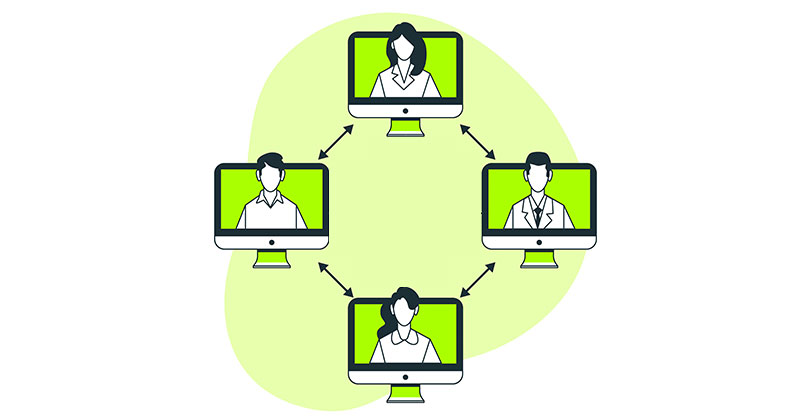The internet as we know it is at a crossroads. The centralized systems we’ve depended on for decades cloud servers, big data centers, and monolithic corporations are showing their cracks. Outages ripple across continents. Breaches expose millions. And the very architecture we rely on is struggling to keep up with the demands of a hyper-connected world.
Enter decentralized networking: a paradigm shift that could redefine how we share, store, and secure data. This isn’t some distant concept; it’s a response to real, tangible flaws in the systems we’ve grown too comfortable with.
Centralized vs. Decentralized: Breaking Down the Difference
At its core, decentralized networking rejects the idea of a single authority controlling information flow. Instead, it distributes control across a network of peers, making every participant both a user and a provider.
Here’s how the two stack up:
| Feature | Centralized Networks | Decentralized Networks |
| Control | Centralized authorities (companies/governments) | Shared across participants |
| Data Storage | Stored on central servers | Distributed across nodes |
| Security | Single point of failure | Resilient, no single point of failure |
| Scalability | Limited by central server capacity | Scales with network participants |
What’s Driving the Shift to Decentralized Networks?
The rise of decentralized systems isn’t about trends but it’s about solving deep-rooted problems in traditional networks.
1. Data Privacy is on Life Support
In a centralized system, your data is someone else’s product. Stored in massive data centers, it’s at constant risk of breaches or misuse. With decentralized networks:
- Your data isn’t stored in one vulnerable location.
- Encryption ensures only authorized users can access information.
- Peer-to-peer systems eliminate intermediaries, reducing exposure to third-party misuse.
2. Outages Show the Fragility of Centralized Systems
From cloud platform failures to service disruptions, centralized systems have a history of collapsing under pressure.
- A single outage can bring down entire services (think streaming, banking, or communication apps).
- Decentralized systems reroute data dynamically, ensuring continuity even if parts of the network fail.
3. Power and Accountability
Centralized networks place immense power in the hands of a few. With decentralization:
- Power is distributed, reducing risks of abuse or manipulation.
- Systems become transparent and accountable, especially in areas like finance and governance.
Applications of Decentralized Networking
The beauty of decentralized systems lies in their versatility. These aren’t just theoretical models; they’re actively shaping industries.
Blockchain Networks
Blockchain is often synonymous with cryptocurrency, but its potential goes far beyond digital currency.
- Use Case: Smart contracts for automating agreements without intermediaries.
- Impact: Removes the need for banks or brokers, making financial systems leaner and more secure.
Mesh Networks
When traditional infrastructure fails, mesh networks step in. These networks connect devices directly, creating a web of communication without relying on cellular towers or internet providers.
- Use Case: Disaster relief or rural connectivity.
- Impact: Provides communication in areas with no existing infrastructure.
Decentralized Storage Systems (e.g., IPFS)
Centralized cloud storage systems have limits. Decentralized storage distributes files across nodes, ensuring:
- Use Case: Hosting critical files with resilience to tampering or loss.
- Impact: No single server holds all the data, reducing risks of censorship or data loss.
Benefits That Speak Volumes
Decentralized networking isn’t just a technical leap as it’s a solution to problems that impact users, businesses, and industries every day.
1. Improved Privacy
- No central entity holds all your personal data.
- Encryption ensures that data remains private even from network operators.
2. Fault Tolerance
- No single point of failure means networks remain operational even during outages or attacks.
- Ideal for mission-critical systems like healthcare, military, and finance.
3. Autonomy and Reduced Dependency
- Users control their own data and communication channels.
- Businesses can operate without relying on third-party platforms prone to sudden policy changes.
The Challenges We Can’t Ignore
For all its promise, decentralized networking isn’t without its hurdles. These challenges demand innovative solutions:
1. Network Synchronization
Keeping decentralized networks synchronized is tough. Blockchain, for example, struggles with transaction speed due to this issue.
- Problem: Conflicting updates when nodes aren’t aligned in real-time.
- Possible Solution: Layered architectures or hybrid models to balance speed with decentralization.
2. Scalability
Decentralized systems can grow only as fast as their infrastructure allows.
- Problem: A massive influx of users can strain networks.
- Possible Solution: Incorporating advanced protocols like sharding to distribute the load effectively.
3. Legal and Ethical Concerns
Without a central authority, decentralized systems risk being misused.
- Problem: Lack of oversight can enable illegal activities.
- Possible Solution: Community-driven governance models to ensure ethical standards.
Industries Poised for Transformation
Decentralized networking isn’t just for tech enthusiasts. Its potential extends into everyday life, reshaping industries in meaningful ways.
1. Finance
- Decentralized finance (DeFi) platforms already allow peer-to-peer lending, borrowing, and trading without banks.
- With decentralized networks, financial systems could become truly global and inclusive.
2. Gaming
- Gamers could trade virtual assets securely, without relying on publishers or marketplaces.
- Decentralized game worlds allow players to own and monetize their creations.
3. Internet of Things (IoT)
- IoT devices could form secure, decentralized networks, sharing data without cloud dependency.
- Applications range from smart cities to autonomous vehicles communicating in real time.
What Lies Ahead: Decentralization’s Untapped Potential
The future of decentralized networking is vast, with innovations just beginning to take shape.
1. Hybrid Systems
Expect a blend of centralized and decentralized systems to emerge, combining the efficiency of traditional models with the security of decentralization.
2. Decentralized AI
AI models trained and executed on decentralized networks could democratize access, removing the monopoly of big tech.
3. Cross-Industry Integration
Decentralized systems won’t just exist in silos as they’ll connect industries, creating a web of interoperable, resilient networks.
The Road Ahead
Decentralized networking isn’t a silver bullet, but it’s a necessary evolution. In a world where centralized systems are buckling under pressure, decentralization offers an alternative that’s secure, transparent, and future-proof.
The shift won’t happen overnight. However, as outages grow more frequent, breaches become more devastating, and trust in centralized authorities continues to erode, the case for decentralized networking becomes impossible to ignore. The future of connectivity might not rely on monolithic servers but on you, me, and the collective strength of a network without borders. Your business deserves more than outdated tech and temporary fixes.
At IT Solutions.CA, we deliver innovative IT services including network cabling in Toronto, ON to keep your business secure, efficient, and future-ready.



